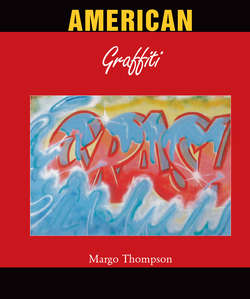Читать книгу American Graffiti - Margo Thompson - Страница 12
На сайте Литреса книга снята с продажи.
Subway Writers
BLADE
ОглавлениеBLADE belonged to the first generation of graffiti writers, a peer of ‘Old School’ writers like PHASE 2 whose tagging careers began in the early 1970s and were documented in the 1974 book, The Faith of Graffiti. From the Bronx, he began tagging trains in 1972, and he kept a list of his tags, organised by train car numbers. By 1980 he had completed five thousand pieces.[60] BLADE advanced stylistic developments in graffiti throughout the 1970s: he painted clouds to establish a neutral ground for his tag, he wrote in bubble letters, he used shadows to create a three-dimensional effect, and he was the first to use a character in a masterpiece: a snowman in November 1974, on a Christmas-themed car.[61] He continued to use characters of his own devising to animate his pieces, such as Joint Man, Dancing Ladies, and the Galaxy Gangster.[62] By 1976, he had mastered not only three-dimensional forms that seem to pop out from the plane of the subway car, but also an illusion of space that extended back into the picture plane.[63] This facility was evident in his 1980 swinging letters masterpiece, where his tag seemed to have become animated and filled the side of the train car, top to bottom and end to end. There was a blue sky background, with puffy white clouds. Each letter seemed to pivot freely, like a car on a Ferris wheel, suspended between a pair of metal legs: the B rocked back, the A swung forward, and the D looked ready to fly up and around its axle. The letters were shadowed in black so that they looked substantial and seemed to project into space, especially against the actual sky as the train crossed an overpass, as in this photograph. Four round faces with big cartoon eyes to the right of the E were smaller than the letters and were graduated in size so that they appeared to recede into the pictorial space.
BLADE told New York Times reporter Grace Glueck in 1983, ‘I wanted to do the most and be the best at it’.[64] This was an unusual ambition. Generally, graffiti writers aimed for quantity, and while a distinctive style was admirable, it was not a substitute for ubiquity on a particular subway line in gaining a reputation as ‘king’ of the line. Thus, it was not inevitable that a prolific tagger would become known for producing masterpieces, because the time needed to execute an elaborate, multi-coloured, whole-car design could have been spent on scores of simpler tags. BLADE was unique in his desire to produce large, striking designs in quantity. He spent about ten hours on an end-to-end piece with his name centred over the middle doors in 1980. The blocky, blue-green letters followed the conventions of linear perspective with the vanishing point in the centre of the A. The A was the farthest back in space, and it appeared to be folded so that the whole tag angled into the atmospheric bands of white, gold, and orange behind it. This central design was set off by a pair of broad red arcs that separated the deep space from black areas of indeterminate depth at either side. An atomic blast in red, white, and blue was to the left and to the right was a pop-eyed head. Richard Goldstein, the Village Voice art critic, took it to be a reference to the famous painting, The Scream: ‘A subway Munch raises the heady possibility that art can happen anywhere’.[65] Any resemblance was unintentional, though: the artist said he was not familiar with Munch’s painting when he produced his image. Rather, he claimed to be self-referential: the figure expressed awe of the writer’s ability to break the picture plane, and craned his neck, wide-eyed.[66]
SEEN, Tag, 1981. Aerosol paint on subway car. New York.
60
Stewart, 444, 455.
61
Stewart, 447.
62
David Villorente and Todd James, Mascots and Mugs: The Characters and Cartoons of Subway Graffiti (New York: Testify Books, 2007), 31.
63
Stewart, 448–50.
64
Grace Glueck, “Gallery View: On Canvas, Yes, But Still Eyesores,” The New York Times, 25 December 1983, H22.
65
Richard Goldstein, “The Fire Down Below,” 55.
66
Interview with BLADE, 25 July 2006.
